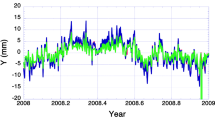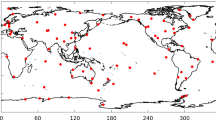Abstract
Accurate geocenter location is of great importance for improving the realization of terrestrial reference frame. By virtue of their lower orbit altitude, low Earth orbit (LEO) satellites naturally have a promising advantage in sensing the geocenter variations. However, more complex orbit modeling for LEO satellites with respect to those at higher altitudes poses a challenge for the geocenter estimation, despite the numerous onboard GNSS observations provided by recently increased number of LEO satellites. The purpose of this study is to investigate the performance of geocenter motion (relative position of center of mass of the whole Earth system with respect to center-of-figure of the solid Earth’s surface) estimates using multi-LEO onboard GNSS observations and dynamic force models. Three years of onboard data from seven LEO satellites are processed. We first study the impact of solar radiation pressure modeling and ambiguity fixing on the derived geocenter motion from the view of the single-LEO solution. The results show that the imperfects in a priori bow-wing models of LEO satellites can introduce significant distortions in the derived geocenter coordinates. The additional estimation of scale parameters accounting for the deficiency of a priori models can greatly remove the majority of orbital artifacts in the geocenter coordinates. With the application of the ambiguity fixing, the formal errors of geocenter coordinates are significantly reduced by over 80% for the equatorial component and 28% for the Z component. Our experiments on GRACE-FO satellites indicate that the solution using dynamic models can achieve a good consistency with the solution using accelerometer measurements at the annual frequency. The switch from accelerometer measurements to dynamic models leads to annual amplitude changes of less than 0.5 mm in the equatorial component and 1 mm in the Z component. In addition, compared to the single-LEO solutions, the multi-LEO combined solution contributes to a better decorrelation of parameters, enabling the geocenter coordinates to be less contaminated by orbit modeling deficiencies. The comparison with external solutions derived from LEO and SLR data shows a good agreement with the multi-LEO solution in both the annual amplitude and phase.










Similar content being viewed by others
Data availability
The GRACE-FO data are released at https://podaac.jpl.nasa.gov/GRACE-FO. The Swarm data can be downloaded from ESA at https://earth.esa.int/eogateway/missions/swarm/data, while the Sentinel-3 onboard observations are available at https://scihub.copernicus.eu. The CODE GPS products used in this study can be publicly accessed at https://cddis.nasa.gov. The SLR solutions provided by ILRS are freely available at ftp://edc.dgfi.tum.de/pub/slr/products.
References
Abraha K, Teferle F, Hunegnaw A, Dach R (2018) Effect of unmodelled tidal displacements in GPS and GLONASS coordinate time series. Geophys J Int 214(3):2195–2206. https://doi.org/10.1093/gji/ggy254
Altamimi Z, Rebischung P, Collilieux X, Métivier L, Chanard K (2023) ITRF2020: an augmented reference frame refining the modeling of nonlinear station motions. J Geod 97:47. https://doi.org/10.1007/s00190-023-01738-w
Bertiger W, Desai SD, Haines B, Harvey N, Moore AW, Owen S, Weiss JP (2010) Single receiver phase ambiguity resolution with GPS data. J Geod 84(5):327–337. https://doi.org/10.1007/s00190-010-0371-9
Blewitt G, Lavallée D (2002) Effect of annual signals on geodetic velocity. J Geophys Res Solid Earth 107(B7):ETG9–ETG11. https://doi.org/10.1029/2001JB000570
Brockmann E (1997) Combination of solutions for geodetic and geodynamic applications of the global positioning system (GPS). Ph.D. thesis, Astronomical Institute University of Berne
Couhert A, Delong N, Ait-Lakbir H, Mercier F (2020) GPS-based LEO orbits referenced to the earth’s center of Mass. J Geophys Res: Solid Earth. https://doi.org/10.1029/2019JB018293
Dong D, Yunck T, Heflin M (2003) Origin of the international terrestrial reference frame. J Geophys Res 108:2200. https://doi.org/10.1029/2002JB002035
Fernández Martìn C (2016) Sentinel-3A properties for GPS POD, GMV-GMESPOD-TN-0027, v1.2
Fletcher K (2012) Sentinel-3-ESA’s global land and ocean mission for GMES operational services. ESA, Noordwijk
Folkner W, Williams J, Boggs D (2009). The planetary and lunar ephemeris DE 421 (IPN Progress Report 42–178). Jet Propulsion Laboratory
Förste C, Bruinsma S, Abrikosov O, Rudenko S, Lemoine JM, Marty JC, Biancale R (2016). EIGEN-6S4 A time-variable satellite-only gravity field model to d/o 300 based on LAGEOS, GRACE and GOCE data from the collaboration of GFZ Potsdam and GRGS Toulouse. V. 2.0. GFZ Data Services
Friis-Christensen E, Lühr H, Knudsen D, Haagmans R (2008) Swarm-an earth observation mission investigating geospace. Adv Space Res 41(1):210–216. https://doi.org/10.1016/j.asr.2006.10.008
Glaser S, Michalak G, Männel B, König R, Hans Neumayer K (2020) Reference system origin and scale realization within the future GNSS constellation “Kepler.” J Geod 94:117. https://doi.org/10.1007/s00190-020-01441-0
Griffiths J, Ray JR (2013) Sub-daily alias and draconitic errors in the IGS orbits. GPS Solut 17:413–422. https://doi.org/10.1007/s10291-012-0289-1
Haines BJ, Bar-Sever YE, Bertiger WI, Desai SD, Harvey N, Sibois AE, Weiss JP (2015) Realizing a terrestrial reference frame using the global positioning system. J Geophys Res: Solid Earth 120:5911–5939. https://doi.org/10.1002/2015JB012225
Huang W, Männel B, Sakic P, Ge M, Schuh H (2020) Integrated processing of ground- and space-based GPS observations: improving GPS satellite orbits observed with sparse ground networks. J Geod 94:96. https://doi.org/10.1007/s00190-020-01424-1
Johnston G, Riddell A, Hausler G (2017) The international gnss service. In: Teunissen PJG, Montenbruck O (eds) Springer handbook of global navigation satellite systems, 1st edn. Springer International Publishing, Cham, Switzerland, pp 967–982. https://doi.org/10.1007/978-3-319-42928-1
Kang Z, Tapley B, Chen J, Ries J, Bettadpur S (2009) Geocenter variations derived from GPS tracking of the GRACE satellites. J Geod 83(10):895–901. https://doi.org/10.1007/s00190-009-0307-4
Kang Z, Tapley B, Chen J, Ries J, Bettadpur S (2019) Geocenter motion time series derived from GRACE GPS and LAGEOS observations. J Geod 93:1931–1942. https://doi.org/10.1007/s00190-019-01292-4
König R, Dahle C, Vei M, Neumayer KH (2015) A geocenter time series from a combination of LAGEOS and GRACE observations. IAG Symposia. Springer, Berlin, pp 1–6. https://doi.org/10.1007/1345_2015_24
Kuang D, Bar-Sever Y, Haines B (2015) Analysis of orbital configurations for geocenter determination with GPS and low-earth orbiters. J Geod 89(5):471–481. https://doi.org/10.1007/s00190-015-0792-6
Kuang D, Bertiger W, Desai S, Haines B, Yuan D (2019) Observed geocenter motion from precise orbit determination of GRACE satellites using GPS tracking and accelerometer data. J Geod 93:1835–1844. https://doi.org/10.1007/s00190-019-01283-5
Landerer FW, Flechtner FM, Save H, Webb FH, Bandikova T, Bertiger WI et al (2020) Extending the global mass change data record: GRACE follow-on instrument and science data performance. Geophys Res Lett 47:e2020GL088306. https://doi.org/10.1029/2020GL088306
Lavallee DA, van Dam T, Blewitt G, Clarke PJ (2006) Geocenter motions from GPS: a unified observation model. J Geophys Res 111:B05405. https://doi.org/10.1029/2005JB003784
Li X, Wang Q, Wu J, Yuan Y, Yun X, Gong Xue WuZ (2022) Multi-GNSS products and services at iGMAS Wuhan innovation application center: strategy and evaluation. Satell Navig 3:20. https://doi.org/10.1186/s43020-022-00081-3
Lu C, Zhang Q, Zhang K, Zhu Y, Zhang W (2019) Improving LEO precise orbit determination with BDS PCV calibration. GPS Solut 23:109. https://doi.org/10.1007/s10291-019-0899-y
Lutz S, Meindl M, Steigenberger P, Beutler G, Sośnica K, Schaer S, Dach R, Arnold D, Thaller D, Jäggi A (2016) Impact of the arc length on GNSS analysis results. J Geod 90:365–378. https://doi.org/10.1007/s00190-015-0878-1
Lyard F, Lefevre F, Letellier T, Francis O (2006) Modelling the global ocean tides: modern insights from FES2004. Ocean Dyn 56:394–415. https://doi.org/10.1007/s10236-006-0086-x
Männel B, Rothacher M (2017) Geocenter variations derived from a combined processing of LEO-and ground-based GPS observations. J Geod 91:933–944. https://doi.org/10.1007/s00190-017-0997-y
Mao X, Arnold D, Girardin V, Villiger A, Jäggi A (2021) Dynamic GPS-based LEO orbit determination with 1 cm precision using the bernese GNSS software. Adv Space Res 67(2021):788–805. https://doi.org/10.1016/j.asr.2020.10.012
Meindl M, Beutler G, Thaller D, Dach R, Jäggi A (2013) Geocenter coordinates estimated from GNSS data as viewed by perturbation theory. Adv Space Res 51(7):1047–1064. https://doi.org/10.1016/j.asr.2012.10.026
Montenbruck O, Hackel S, Jäggi A (2018a) Precise orbit determination of the Sentinel-3A altimetry satellite using ambiguity-fixed GPS carrier phase observations. J Geod 92(7):711–726. https://doi.org/10.1007/s00190-017-1090-2
Montenbruck O, Hackel S, van den Ijssel J, Arnold D (2018b) Reduced dynamic and kinematic precise orbit determination for the swarm mission from 4 years of GPS tracking. GPS Solut 22:79. https://doi.org/10.1007/s10291-018-0746-6
Pearlman MR, Noll CE, Pavlis EC, Lemoine FG, Combrink L, Degnan JJ, Kirchner G, Schreiber U (2019) The ILRS: approaching 20 years and planning for the future. J Geod 93:2161–2180. https://doi.org/10.1007/s00190-019-01241-1
Petit G, Luzum B (2010). IERS conventions 2010. No. 36 in IERS Technical note. Frankfurt am Main, Germany: Verlag des Bundesamtes für Kartographie und Geodäsie
Picone JM, Hedin AE, Drob DP, Aikin AC (2002) NRLMSISE-00 empirical model of the atmosphere: statistical comparisons and scientific issues. J Geophys Res 107:SIA151–SIA1516. https://doi.org/10.1029/2002JA009430
Rebischung P, Schmid R (2016). IGS14/igs14.atx: a new Framework for the IGS Products [C]. AGU Fall Meeting
Rebischung P, Altamimi Z, Springer T (2014) A collinearity diagnosis of the GNSS geocenter determination. J Geod 88:65–85. https://doi.org/10.1007/s00190-013-0669-5
Rodriguez-Solano CJ, Hugentobler U, Steigenberger P, Bloßfeld M, Fritsche M (2014) Reducing the draconitic errors in GNSS geodetic products. J Geod 88:559–574. https://doi.org/10.1007/s00190-014-0704-1
Scaramuzza S, Dach R, Beutler G, Arnold D, Sušnik A, Jäggi A (2018) Dependency of geodynamic parameters on the GNSS constellation. J Geod 92(1):93–104. https://doi.org/10.1007/s00190-017-1047-5
Schaer S, Villiger A, Arnold D, Dach R, Prange L, Jäggi A (2021) The CODE ambiguity-fixed clock and phase bias analysis products: generation, properties, and performance. J Geod 95:81. https://doi.org/10.1007/s00190-021-01521-9
Sośnica K, Jäggi A, Thaller D, Beutler G, Dach R (2014) Contribution of Starlette, Stella, and AJISAI to the SLR-derived global reference frame. J Geod 88(8):789–804. https://doi.org/10.1007/s00190-014-0722-z
Tseng T, Hwang C, Sośnica K, Kuo C, Liu Y, Yeh W (2017) Geocenter motion estimated from GRACE orbits: the impact of F10.7 solar flux. Adv Space Res 59:2819–2830. https://doi.org/10.1016/j.asr.2016.02.003
Wen H, Kruizinga G, Paik M, Landerer F, Bertiger W, Sakumura C, Bandikova T, Mccullough C (2019) Gravity Recovery and Climate Experiment Follow-on (GRACE-FO) level-1 data product user handbook. p 56935
Wu X, Ray J, van Dam T (2012) Geocenter motion and its geodetic and geophysical implications. J Geodyn 58:44–61. https://doi.org/10.1016/J.JOG.2012.01.007
Wu X, Kusche J, Landerer FW (2017) A new unified approach to determine geocenter motion using space geodetic and GRACE gravity data. Geophys J Int 209:1398–1402. https://doi.org/10.1093/gji/ggx086
Zajdel R, Sośnica K, Dach R, Bury G, Prange L, Jäggi A (2019) Network effects and handling of the geocenter motion in multi-GNSS processing. J Geophys Res: Solid Earth 124:5970–5989. https://doi.org/10.1029/2019JB017443
Zajdel R, Sośnica K, Bury G (2021) Geocenter coordinates derived from multi-GNSS: a look into the role of solar radiation pressure modeling. GPS Solut 25:1. https://doi.org/10.1007/s10291-020-01037-3
Zhang K, Li X, Wu J, Yuan Y, Li X, Zhang X, Zhang W (2021) Precise orbit determination for LEO satellites with ambiguity resolution: improvement and comparison. J Geophys Res: Solid Earth. https://doi.org/10.1029/2021JB022491
Acknowledgements
We are very grateful to the Center for Orbit Determination in Europe for providing their precise GPS precise products. This study is financially supported by the National Natural Science Foundation of China (No. 41974027, No. 42374015), the National Key Research and Development Program of China (2021YFB2501102), the Hubei Province Natural Science Foundation (Grant No. 2020CFA002), the Sino-German Mobility Programme (Grant No. M-0054). The numerical calculations in this paper have been done on the supercomputing system in the Supercomputing Center of Wuhan University.
Author information
Authors and Affiliations
Contributions
KZ, XL, and WJ proposed the general idea of this manuscript, analyzed the data, and wrote the paper. YF, YY, JL, and WZ contributed to the paper writing and the data analyses. All authors reviewed the manuscript.
Corresponding author
Ethics declarations
Conflict of interest
The authors declare no conflict of interest.
Additional information
Publisher's Note
Springer Nature remains neutral with regard to jurisdictional claims in published maps and institutional affiliations.
Rights and permissions
Springer Nature or its licensor (e.g. a society or other partner) holds exclusive rights to this article under a publishing agreement with the author(s) or other rightsholder(s); author self-archiving of the accepted manuscript version of this article is solely governed by the terms of such publishing agreement and applicable law.
About this article
Cite this article
Zhang, K., Li, X., Jiang, W. et al. Geocenter motion derived from multi-LEO precise orbit determination based on GNSS observations and dynamic force models. GPS Solut 28, 8 (2024). https://doi.org/10.1007/s10291-023-01546-x
Received:
Accepted:
Published:
DOI: https://doi.org/10.1007/s10291-023-01546-x




